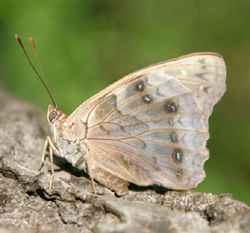Find a Butterfly
Tawny Emperor
Asterocampa clyton
Named
Boisduval and Leconte, 1833

Identification
Wingspan: 2 2 5/8". Similar to Hackberry Emperor (see discussion in previous account), but more reddish orange; forewings with yellow spotting and lacking marginal eyespot. Light brown below, with pattern similar to above.
Distribution
Montana, North Dakota, and Nebraska east to southern Massachusetts, and south to east Texas and the Gulf states. In New England, known from western Connecticut and southwestern Massachusetts.
Status in Massachusetts
Presently known from a single colony in Forest Park, Springfield. The species was unknown in New England during Scudder‘s day. Reinthal found numbers of larvae at big Hackberry trees on the University of Massachusetts campus at Amherst in the years 1957 1959, with 150+ larvae found on 20 August 1957 at one site. There are two specimens from Holyoke (1m, 1f) in the collection of the Carnegie Museum (no other data available). T. Friedlander (pers. comm.) knows of no specimens collected outside of Hampshire and Hampden counties. In general, the species is rare at the northern extremity of its range. In addition, it may be overlooked to a degree because of its habit of flying in the canopy.

Flight Period in Massachusetts
June and July, and perhaps August; exact early and late dates unavailable.
Larval Food Plants
Hackberry (Celtis occidentalis) is the host plant in Massachusetts. Other species of Celtis are utilized elsewhere.
Adult Food sources
The Tawny Emperor visits flowers infrequently, preferring to take nourishment at fermenting fruit, sap flows, and dung.

Habitat
The Tawny Emperor favors more "densely wooded riparian habitats" (Opler and Krizek 1984) than the Hackberry Emperor, although the two may occur together (as in Springfield). In Massachusetts, always associated with Hackberry.
Life Cycle
EGG: Same as Hackberry Emperor. OVIPOSITION: Eggs laid in clusters of 200 500 in multilayered masses. Egg masses placed on canopy leaves in partial sunlight. Host trees chosen are typically mature trees in groves (Friedlander, 1987). LARVA: Similar to Hackberry Emperor, but with branched horns on the head. CHRYSALIS: Similar to Hackberry Emperor.
According to Pease (pers. comm.), Tawny Emperor larvae emerge from the leaf litter a few days later than Hackberry Emperor larvae in the spring. Larvae of this species are far more gregarious than those of the Hackberry Emperor, especially during early instars, when they pack together on host plant leaves.
Account Author
Roger Pease
Additional Information
Read more on this species at the North American Butterfly Association.



